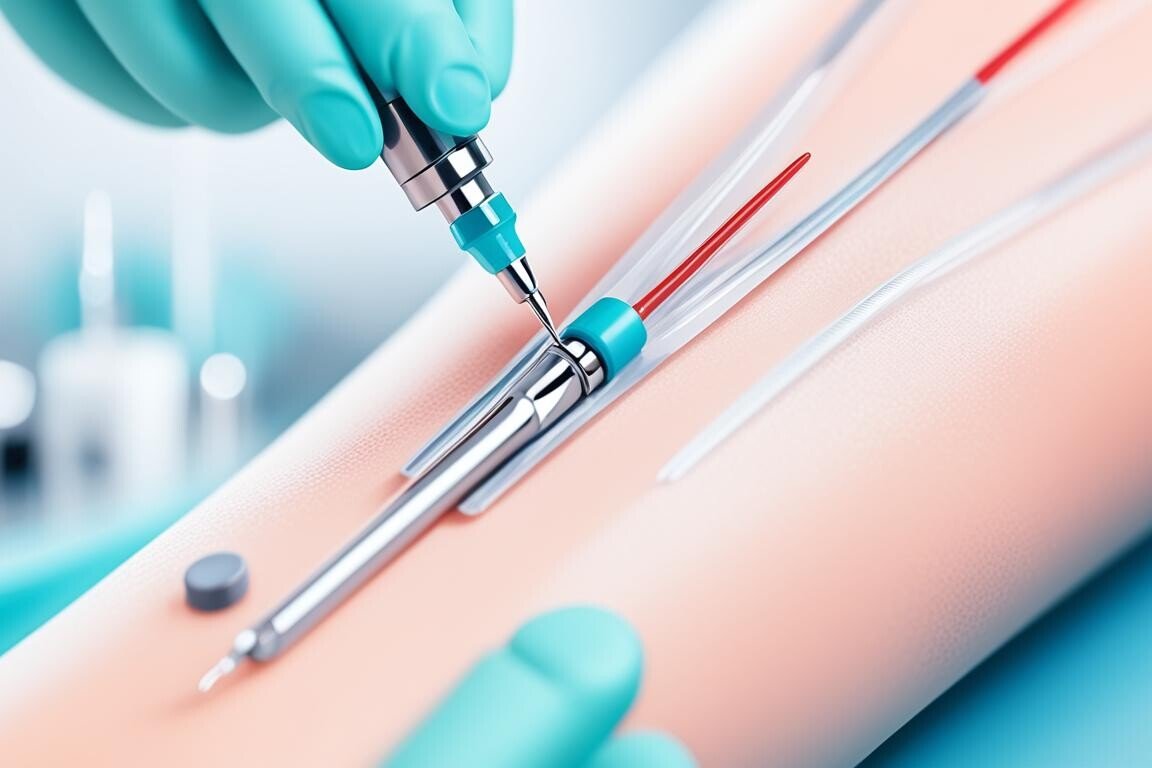We are interventional pain specialists in India, offering advanced, minimally invasive procedures for chronic pain. Our team uses the latest techniques and X-ray or ultrasound imaging. This ensures we target the pain source accurately, offering relief without surgery or long-term meds.
If you’re facing joint pain, nerve issues, or spinal problems, we can help. Our specialists create a treatment plan just for you. We offer options like epidural steroid injections and radiofrequency nerve ablation. Plus, we have regenerative therapies like platelet-rich plasma (PRP) for effective pain relief.
We combine cutting-edge techniques with a focus on you, the patient. Our goal is to improve your life and let you enjoy activities you love. Trust us to provide the care you need for chronic pain management.
Table of Contents
ToggleIntroduction to Interventional Pain Management
Interventional pain management is a way to find and treat the cause of chronic pain. It uses advanced, non-invasive methods. Specialists in this field are trained to create personalized treatment plans. They aim to treat the root cause, not just the symptoms.
This approach is for people with chronic pain that hasn’t gotten better with other treatments. Specialists use treatments like trigger point injections and nerve blocks. These methods help provide lasting relief and improve life quality.
These procedures work well for many pain conditions, including myofascial pain and chronic headaches. Each patient’s results can vary. But the goal is to use less invasive methods to reduce pain and enhance well-being.
Specialists in interventional pain management work with other health experts. They include physical therapists and primary care doctors. Their focus is mainly on the spine and joints, helping with neck, back, and muscle issues.

Minimally Invasive Procedures for Chronic Pain Relief
Minimally invasive procedures are changing the game for chronic pain management. These methods offer targeted treatments that are less invasive than traditional surgeries. This means less pain, quicker recovery, and fewer complications for patients.
Vertiflex Superion® Indirect Decompression
The Vertiflex Superion® Indirect Decompression is a key example. It helps with lumbar spinal stenosis symptoms. A small, flexible device is placed between two vertebrae through a tiny cut. This creates more space in the spinal canal to ease nerve pressure.
Dekompressor Discectomy
The Dekompressor Discectomy targets compressed nerve pain from herniated discs. Doctors use a small tube and drill to shave a tiny part of the disc nucleus. This gives nerves more room to breathe.
Intradiscal Electrothermal Therapy (IDET)
IDET is for those with lower back pain from herniated discs or degenerative disc disease. A catheter and heating wire are inserted near the disc. Heat thickens the disc’s collagen, closing small tears and cracks.
These procedures offer hope for chronic pain relief. They can improve life quality and help patients stay active. By targeting pain causes, patients see symptom relief and better overall health.
Injections for Pain Management
Interventional pain specialists offer targeted injections for chronic pain. These procedures are minimally invasive. They help with pain in the spine, joints, and other body areas.
Epidural Steroid Injections
Epidural steroid injections help with pain in the neck, shoulders, arms, and more. This pain can come from a herniated disc, degenerative disc disease, or arthritis. Doctors use X-rays to inject anti-inflammatory pain medications right where it hurts.
This reduces inflammation and brings relief.
Facet Joint Injections and Medial Branch Blocks
These injections are guided by X-rays and target the small spine joints. Arthritis in these joints can cause pain in the head and back. The procedure takes about 5 minutes and can be done with local anesthesia or sedation.

Radiofrequency Procedures
If you have chronic back or neck pain, radiofrequency nerve ablation might help. This procedure uses heat to temporarily block the nerves that cause pain. It’s done with X-rays to guide it and can ease pain for six months to two years.
This method treats many pain types, like facet joint pain and discogenic back pain. It’s great for chronic pain that other treatments haven’t helped.
Pulsed radiofrequency (PRF) and water-cooled radiofrequency (WCRF) are top choices for pain relief. Cryoneurolysis uses cold to stop nerve function, without causing more sensitivity or neuromas.
The procedure takes about 20 minutes and you can go back to normal in 1-3 days. It’s done with local anesthesia or light sedation. Experts with lots of experience should do it for the best results and safety.

Are you tired of back or neck pain? Talk to your doctor about radiofrequency nerve ablation. This new treatment can give you lasting relief and improve your life.
Interventional pain specialists for Joint Pain Relief
Interventional pain specialists offer effective treatments for joint pain. They perform major joint injections and muscle and joint injections under ultrasound guidance. These procedures help manage pain from conditions like osteoarthritis.
Major Joint Injections
Major joint injections can ease pain for those with osteoarthritis or other joint issues. Specialists use X-rays or ultrasound to guide the injection. They inject medications like corticosteroids or hyaluronan into the joint.
This targeted treatment reduces pain and improves mobility. The whole process takes about 2 minutes.
Muscle and Joint Injections Under Ultrasound Guidance
For neck pain and tennis elbow, specialists use ultrasound-guided injections. They inject a local anesthetic and a low-dose steroid into the affected area. This method is minimally invasive and can greatly reduce pain and improve function.
The procedure usually takes around 15 minutes.
If you’re struggling with joint or muscle pain, our clinic’s interventional pain specialists can help. They aim to relieve your pain and enhance your quality of life.

Advanced Regenerative Therapies
Platelet-Rich Plasma (PRP) Therapy
Platelet-rich plasma (PRP) therapy uses your body’s healing powers. It’s a way to heal soft tissue injuries like ligaments and tendons, and even cartilage injuries. This therapy uses your own blood to help you heal.
First, your doctor takes a small blood sample from your arm. Then, this blood is spun in a centrifuge to get the platelets. These platelets are full of growth factors that help healing. The platelet-rich plasma is then injected into the injured area, using ultrasound for accuracy.
You might start feeling better and less pain in about 6 weeks after PRP therapy. This treatment uses your body’s healing powers to fix the injury. It helps you avoid surgery and long recovery times, so you can enjoy activities again.

If you have a soft tissue, tendon, or cartilage injury, consider PRP therapy. It’s a natural way to lessen pain and aid in recovery.
Nerve Blocks for Targeted Pain Relief
Nerve blocks are a great way to target pain relief. The occipital nerve block is especially helpful for headaches and migraines. These nerves at the back of the head send pain signals from the head and neck.
A healthcare provider, often an interventional pain specialist, injects a local anesthetic and sometimes a small dose of corticosteroid into the area of the greater and lesser occipital nerves. This quick procedure, taking about 30 seconds, can bring fast pain relief for many people.
Occipital Nerve Blocks
Occipital nerve blocks are great for those with recurrent headaches, migraines, or other head and neck pain. It stops pain signals through the occipital nerves, helping to ease discomfort.
- Occipital nerve blocks are a proven and safe way to treat chronic headaches and migraines.
- The procedure is quick, taking just a few minutes, and relief can last weeks or months.
- It’s often used with other treatments, like preventive medicines, for better pain control.
For those looking for relief from occipital nerve blocks, headaches, or migraines, this procedure can be a big help. Working with an interventional pain specialist, patients can find a targeted way to manage their pain and enhance their life quality.

Spinal Interventions
Interventional pain specialists offer advanced procedures for chronic spinal conditions. These include kyphoplasty (balloon kyphoplasty) and spinal cord stimulation.
Kyphoplasty (Balloon Kyphoplasty)
Kyphoplasty, or balloon kyphoplasty, is a minimally invasive treatment for spinal fractures, like vertebral compression fractures. A small balloon is inserted through a tiny incision in the back. It goes to the fracture site.
The balloon is then inflated to move the broken bone back into place. After that, a cement-like material is injected to keep the area stable. This whole process is done under local anesthesia and sedation in an operating room.
Spinal Cord Stimulation
Spinal cord stimulation helps manage chronic pain, including failed back surgery pain and complex regional pain syndrome (CRPS). First, a trial phase involves placing an electrode on the skin to stimulate the spinal cord.
If it helps with pain, a permanent electrode is put under the skin, near the spinal nerves or cord. Patients learn how to use the electrical stimulation to block pain signals. This gives them long-term relief.

Interventional pain specialists are key in picking the right spinal intervention for each patient. They use these advanced methods to help patients find lasting relief from chronic spinal pain. This improves their quality of life.
Interventions for Abdominal Pain
Managing persistent abdominal pain can be tough. But, interventional pain management techniques can help a lot. One effective method is the celiac plexus block. This involves injecting medication into or near the nerves around the main abdominal artery. It blocks pain signals from the abdomen to the brain.
The celiac plexus block is great for treating pain from chronic pancreatitis, abdominal adhesions, and some cancers. It stops pain from traveling to the brain. This procedure is minimally invasive and can give relief for weeks or months. It’s also a good option for those who haven’t found relief with regular pain meds.
This block is done under image guidance like fluoroscopy or ultrasound. It’s usually done as an outpatient. After the procedure, you might feel numbness or weakness in your abdomen. But these effects are usually mild and go away in a few hours. It’s important to follow post-procedure care to avoid any complications.
If you’re dealing with ongoing abdominal pain, the celiac plexus block could be a game-changer. It offers targeted relief and can improve your quality of life.
Implantable Pain Management Devices
Intrathecal Pump Implant
For people with chronic pain from cancer, pancreatitis, or complex regional pain syndrome, or spasticity from disorders like multiple sclerosis and cerebral palsy, the intrathecal pump implant can change their lives. This device is placed surgically by pain specialists. It delivers a steady dose of pain medicine right to the spinal cord for long-term relief.
The surgery is done through a small cut in the abdomen. The pump is put near the spinal cord. Patients then see their doctor regularly for refills or adjustments. This method targets pain at its source. It helps manage chronic pain, cancer pain, and spasticity without the usual side effects of oral drugs.
Interventional pain management has evolved a lot. The intrathecal pump implant is now a top choice for treating severe, ongoing pain. With the help of their healthcare team, patients can find relief and improve their quality of life with this and other new treatments.
Procedure Selection by interventional pain specialists
Managing chronic pain requires the expertise of interventional pain specialists. They create personalized treatment plans. They use advanced, minimally invasive procedures to target pain at its source.
The choice of procedure depends on the patient’s condition, medical history, and pain symptoms. It also depends on the specialist’s skills and experience. This ensures the treatment plan meets the patient’s specific needs for the best results.
Our clinic’s specialists use a team approach to manage pain. They know a lot about the body’s anatomy, how to examine patients, and how to use imaging and other tests. This helps them find the real cause of pain and choose the right procedure for relief.
If you have spinal injuries, degenerative disc disease, pinched nerves, arthritis, joint disorders, or pain from past surgeries, our specialists can help. They create a treatment plan just for you to help you take back control of your life.
Getting certified as an interventional pain specialist is tough. They must finish an Anesthesiology residency, work in pain management for two years, and pass a big exam. This ensures they have the skills and knowledge for top-notch treatments.
Our specialists are all about offering the latest, least invasive procedures. They aim to give you lasting pain relief and improve your life quality.
Risks and Complications of Interventional Pain Treatments
Interventional pain treatments can help relieve pain, but they also come with risks and complications. These risks are rare but can include infection, bad reactions to medicines, and blockages from injecting into a blood vessel.
Doctors take steps to lower these risks. They use clean techniques, watch the medicine amounts, and use imaging to place the needle right. Some people, like those with infections or blood clotting problems, might need special care or shouldn’t have these treatments.
Here are some complications that can happen with these treatments:
- Bacterial meningitis and cauda equina syndrome from epidural steroid shots
- Risks of epidural and transforaminal steroid shots in the spine, including cases of paraplegia
- Discitis after lumbar epidural corticosteroid injection
- Paralysis following transforaminal epidural injection combined with previous spinal surgery
- Hematogenous pyogenic facet joint infections
- Cerebrospinal fluid (CSF) leakage and post-dural puncture headaches from epidural injections
- Epidural hematomas and intramedullary spinal cord hemorrhage following lumbar and cervical epidurals
- Epidural abscesses and bacterial meningitis after lumbar interlaminar injections
Even though complications are rare, it’s important to talk about the risks and benefits with your interventional pain specialists before starting a treatment. Choosing the right patients, following safety steps, and watching closely can help make these treatments safer and more effective for pain relief.
Conclusion
If you’re dealing with chronic pain, there’s hope for lasting relief. Specialists in India offer advanced, minimally invasive treatments. They use the latest techniques to target the root of your pain. This means more than just masking your symptoms.
These experts help you take back control of your life. They offer solutions for back, neck, or joint pain. Options like epidural injections and radiofrequency ablation can bring you long-term relief.
Don’t let chronic pain control your life. Discover how interventional pain management can change everything. Reach out to the experts at the Medical Rehabilitation Center in Kolkata. They’ll find a custom solution for you, leading you to a life without pain.
FAQ
What types of advanced, minimally invasive procedures do interventional pain specialists in India offer?
How does interventional pain management differ from traditional pain treatment?
What is the Vertiflex Superion® Indirect Decompression procedure?
How does the Dekompressor Discectomy procedure work?
What is Intradiscal Electrothermal Therapy (IDET)?
How do epidural steroid injections help with pain relief?
What are facet joint injections and medial branch blocks?
How does radiofrequency nerve ablation work?
What types of joint injections are available?
How does platelet-rich plasma (PRP) therapy work?
What are occipital nerve blocks used for?
How does kyphoplasty (balloon kyphoplasty) work?
What is spinal cord stimulation used for?
What is the celiac plexus block used for?
What is the intrathecal pump implant used for?
How do interventional pain specialists select the appropriate procedure for each patient?
What are some of the potential risks and complications of interventional pain procedures?
Risks from these procedures are rare but can include infection and adverse effects from medications. Doctors take steps to minimize these risks. Patients with certain conditions may need extra precautions.
Source Links
- Interventional Pain Management Procedures | Mount Sinai
- What is Interventional Pain Management?
- Interventional Pain Management Procedures | Heilman Center
- Interventional Pain Management – an overview
- A comprehensive overview and scope of interventional pain management
- What is Interventional Pain Management? | OrthoVirginia
About The Author

This article is medically reviewed by Dr. Chandril Chugh, Board-Certified Neurologist, providing expert insights and reliable health information.
Dr. Chandril Chugh is a U.S.-trained neurologist with over a decade of experience. Known for his compassionate care, he specializes in treating neurological conditions such as migraines, epilepsy, and Parkinson’s disease. Dr. Chugh is highly regarded for his patient-centered approach and dedication to providing personalized care.
→ Book a consultation to discover which remedies suit your needs best.




